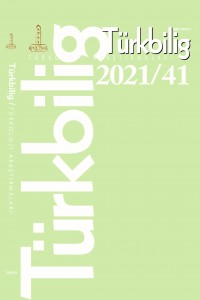Abstract
Eski Türk yazıtları hakkındaki yeni okuma ve anlamlandırma çalışmaları, Eski Türkçe açısından oldukça değerlidir. Yazıtlardaki cümlelerin anlamlandırılması ve okunması konusunda hâlâ sorunlar bulunmaktadır. Yeni yapılacak araştırmalarda, yazıtlara yaklaşımın artık daha ayrıntılı olması beklenmektedir. Ongi yazıtının batı yüzünün 3. satırındaki YwLwqrmzn, YwLRrmzn veya YwLIRrmzn ibaresi şimdiye kadar farklı olarak yorumlanmış ve cümleye değişik anlamlar verilmiştir. Makalede, ibare ve cümle hakkındaki daha önceki teklifler analiz edilmiş ve cümlenin anlamı yeniden değerlendirilmiştir. Bununla beraber, makalede yul- fiili ve türemeleri üzerinde de etimolojik olarak açıklamalar yapılmıştır.
Keywords
References
- Abdullin, İ. A. vd. (1981). Tatar Télénéŋ Aŋlatmalı Süzlégé III: T-H. Kazan: Tatarstan Kitap Neşriyatı.
- Abdurahmonov, G., Rustamov, A. (1982). Kadimgi Turkiy Til. Taşkent: Ukituvçi Naşriyeti.
- Adamović, M. (2020). Alttürkische Themen. Göttingen. (Elyapımı Fotokopi)
- Amanjolov, A. S. (2003). İstoriya i Teoriya Drevnetyurkskogo Pis’ma. Almatı: Mektep.
Abstract
The new readings and interpretations about the Old Turkic Inscriptions are very valuable in terms of Old Turkic. There are still problems with translations and readings the inscriptions. The approach to the inscriptions needs to be more detailed no longer. Detailed explanations should be made on each word for correct understanding of the sentences in the inscriptions. The phrases YwLwqrmzn, YwLRrmzn or YwLIRrmzn are interpreted differently so far and different meanings have been given to it on the 3th line of the western side in the Ongi Inscription. The article analyses previous interpretations of the sentence and evaluates in detail it. The article also gives etymological explanations on the verb yul- and its derivations.
Keywords
References
- Abdullin, İ. A. vd. (1981). Tatar Télénéŋ Aŋlatmalı Süzlégé III: T-H. Kazan: Tatarstan Kitap Neşriyatı.
- Abdurahmonov, G., Rustamov, A. (1982). Kadimgi Turkiy Til. Taşkent: Ukituvçi Naşriyeti.
- Adamović, M. (2020). Alttürkische Themen. Göttingen. (Elyapımı Fotokopi)
- Amanjolov, A. S. (2003). İstoriya i Teoriya Drevnetyurkskogo Pis’ma. Almatı: Mektep.
Details
| Primary Language | Turkish |
|---|---|
| Subjects | Language Studies |
| Journal Section | Research Article |
| Authors | |
| Publication Date | June 29, 2021 |
| Submission Date | April 18, 2021 |
| Published in Issue | Year 2021 Volume: 2021 Issue: 41 |



